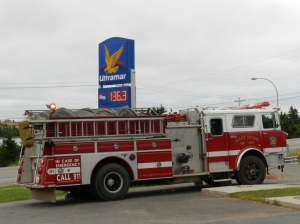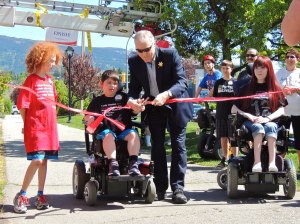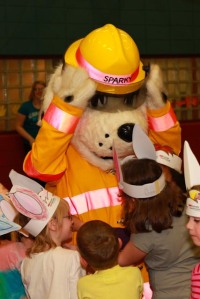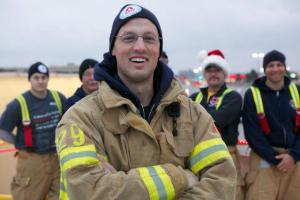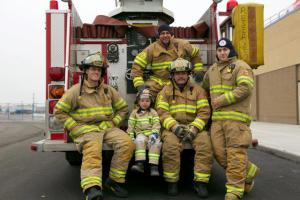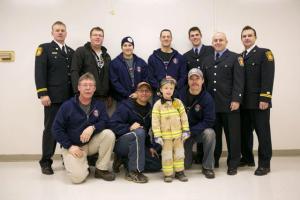 La version française suit.
La version française suit.
Mary Ann Wickham was one of the first volunteers for the Muscular Dystrophy Association of Canada, and her unique contributions to the organization have shaped the Services departments. Her unique approach gave the newly formed MDAC a stronger purpose, and presence. Research was the base of the organization, but providing information, equipment, and care for those affected by neuromuscular disorders rounded out the MDAC. We honour an exceptional volunteer every year in her name with the Mary Ann Wickham Award for Volunteer of the Year.
Below is an excerpt from Connections (MDAC newsletter,) issue from September 1989:
The Lady With The Lift
Thirty-five years ago Mary Ann Wickham got off a bus on the corner of Bay and Wellington Streets in Toronto, looked across the street, and happened to see a sign in a store window – “The Muscular Dystrophy Association of Canada.”
“I knew nothing about muscular dystrophy, but I went in an asked the people there if I could do some volunteer work,” said Wickham, who had just moved to Toronto in 1954 and was working full time as a nurse. “The next week I went to my first Toronto Chapter meeting. Dr. David Green was there, and so was Arthur Minden. When they heard of my nursing background, they asked if I would mind visiting some of the people in Toronto who had muscular dystrophy.”
So began, in these chance circumstances, a new chapter in Mary Ann Wickham’s life that would ultimately determine her future career. But these same lucky circumstances would also help to shape the future of the Muscular Dystrophy Association of Canada as we know it today, turning it into an organization that not only supports medical research, but offers services and information to its clients as well.
For eleven years – from 1954 to 1965 – Mary Ann Wickham was the Client Services staff for the Muscular Dystrophy Association of Canada, always on a volunteer basis. But she also became deeply involved in other Association activities, too: helping to organize social events, starting new MDAC Chapters in other Ontario cities, travelling throughout the province to talk to clubs and groups, and ultimately becoming a member of the MDAC Board.
But Wickham’s primary commitment to MDAC was always visiting clients, at least two nights a week and all day Saturday.
“I kept the equipment in my basement,” she recalled. “If anybody needed a wheelchair or a Hoyer lift, I would deliver it. There were about 30 clients in Toronto then – and it quickly became very frustrating, because I was really not able to visit them all on a routine basis. I ended up with a map on the wall of my house with little pins showing where everyone was, so if I had to make a call in a certain district, I would always make two or three other stops in the vicinity to see how everyone was doing.
“Thirty-five years doesn’t really seem that long ago,” Wickham said, “but compared to those days, the information we have today about neuromuscular diseases and the change in attitudes towards disabled people seem absolutely incredible.”
In 1954 there was no public funding of wheelchairs, for example – “MDAC had to buy all of them,” said Wickham. “And we recycled them, too, again and again. No one had training in fitting wheelchairs either. The only choice was between wheelchairs for adults and those for children, with perhaps a pillow on their back or on the seat to try and make things a little more comfortable.
“Almost no one knew anything about genetics back then or had any notion that muscular dystrophy might be inherited,” she recalled. “One family I spent a lot of time with had three sons with Duchenne muscular dystrophy and two daughters with peroneal muscular atrophy. The poor mother just thought it was bad luck that all these sad things had happened to her family.
“There was no knowledge in the general public that there was more than one kind of muscular dystrophy – everyone just called them all ‘creeping paralysis.’ Many people even thought muscular dystrophy was contagious. Sometimes at the information booths we set up at the Canadian National Exhibition or at local fairs, people would step back, saying they didn’t want to take any brochures, because they might get muscular dystrophy. Families sometimes told me, too, that their child was being kept out of school because other parents were afraid their own children might catch muscular dystrophy.”
Attitudes toward disabled people, even on the part of families who loved them and governments who wanted to help them, have gone through a complete metamorphosis in the past 35 years, too, according to Wickham.
“There was no thought of preparing a child with muscular dystrophy to go to work or to live independently,” she remembered. “Parents just wanted to keep their children at home, to make them as comfortable and happy as possible. Most schools and universities didn’t accept disabled students anyway – there was no transportation available, and all the public buildings were inaccessible.”
It was in this general climate that Mary Ann Wickham began her years of volunteer work on behalf of those people with neuromuscular diseases. She brought her ideas and her experiences with her to MDAC Board meetings in Toronto, always arguing one constant point: to support medical research is extremely important, but the services MDAC could offer its clients were equally important.
“I talked about the human side of my work, about the joy of being able to give a wheelchair to a boy who had never been able to go out shopping with his family… and I think that was what finally convinces many of the Board members.”
In 1965, for the first time in its history, MDAC hired a full time Patient Services staff person, a nurse, who worked out of the Toronto office. Today there are 16 Client Service staff in all regions of Canada, providing the equipment, advice, and information Mary Ann Wickham so ably dispensed all those years as a volunteer.
“I feel gratefully today for my past with the Muscular Dystrophy Association of Canada, that it has been part of my life to feel I was able to contribute something to muscular dystrophy,” said Wickham. “I think the greatest joy I have today is meeting a person who tells me – ‘Years ago you were the first person who contacted me after we had our diagnosis of muscular dystrophy, and I feel very close to you.’”
What was it that Mary Ann Wickham told families 35 years ago when she visited them at night soon after their child was diagnosed?
“Usually I would just sit down and chat with them,” she remembered. “On that first visit, I would tell them as much about the disorder as they were prepared to ask, and no further. Most of all I would say, ‘Please remember, we are here… call if you have any questions. Remember… you are not alone.’”
__________________________________
Today, Muscular Dystrophy Canada is still committed to providing excellent services to those affect by neuromuscular disorders, their families and communities. Please register to stay connected and to receive services.
_________________________________________________________________________
Mary Ann Wickham, fondatrice des services aux clients
 Mary Ann Wickham fut l’une des premières bénévoles de l’Association canadienne de la dystrophie musculaire et sa contribution a façonné l’organisation des services aux clients. Son approche a aussi renforcé l’objectif et la présence de la toute nouvelle organisation. La recherche était la raison d’être de l’ACDM, mais offrir de l’information, des aides techniques et des soins aux personnes atteintes de maladies neuromusculaires venait compléter sa mission. Chaque année, nous remettons le prix Mary-Ann-Wickham à un ou une bénévole d’exception.
Mary Ann Wickham fut l’une des premières bénévoles de l’Association canadienne de la dystrophie musculaire et sa contribution a façonné l’organisation des services aux clients. Son approche a aussi renforcé l’objectif et la présence de la toute nouvelle organisation. La recherche était la raison d’être de l’ACDM, mais offrir de l’information, des aides techniques et des soins aux personnes atteintes de maladies neuromusculaires venait compléter sa mission. Chaque année, nous remettons le prix Mary-Ann-Wickham à un ou une bénévole d’exception.
Voici un extrait du numéro de septembre 1989 de Connexions, le bulletin d’information de l’ACDM.
La dame au lève-personne
Il y a 35 ans, Mary Ann Wickham descendit de l’autobus à l’angle des rues Bay et Wellington à Toronto. L’enseigne d’une vitrine de l’autre côté de la rue accrocha son regard : « L’Association canadienne de la dystrophie musculaire ».
« Je ne savais rien de la dystrophie musculaire, mais j’ai poussé la porte et j’ai demandé aux gens qui s’y trouvaient s’ils avaient besoin de bénévoles », raconte Mme Wickham, qui venait tout juste de déménager à Toronto en 1954 et travaillait à plein temps comme infirmière. « La semaine suivante, j’assistais à ma première rencontre de la section locale de Toronto. Le Dr David Green était là, ainsi qu’Arthur Minden. Lorsqu’ils ont su que j’étais infirmière, ils m’ont demandé si j’accepterais de visiter certaines personnes de Toronto atteintes de dystrophie musculaire. »
Et c’est dans ces circonstances fortuites qu’a débuté un nouveau chapitre de la vie de Mary Ann Wickham, un chapitre qui allait un jour déterminer l’avenir de sa carrière. Mais ces mêmes circonstances allaient aussi aider à façonner l’avenir de l’Association canadienne de la dystrophie musculaire telle que nous la connaissons aujourd’hui, la transformant en un organisme qui non seulement appuie la recherche médicale mais offre aussi des services et de l’information à ses clients.
Pendant onze ans, de 1954 à 1965, Mary Ann Wickham fut, à elle seule, le service aux clients de l’Association, toujours à titre bénévole. Mais elle était aussi fortement impliquée dans d’autres activités de l’organisme, aidant à organiser des événements sociaux, mettant sur pied de nouvelles sections locales de l’ACDM dans d’autres villes de l’Ontario, parcourant la province pour faire des présentations à divers clubs et groupes et, au bout de quelques années, devenant membre du conseil d’administration de l’ACDM.
Mais son premier engagement envers l’ACDM fut toujours la visite des clients qu’elle effectuait au moins deux soirs par semaine et toute la journée du samedi.
« Les aides techniques étaient entreposées dans mon sous-sol », se rappelle-t-elle. « Si quelqu’un avait besoin d’un fauteuil roulant ou d’un lève-personne Hoyer, je m’occupais de la livraison. À l’époque, il y avait une trentaine de clients à Toronto et, très rapidement, la situation est devenue très frustrante puisque je ne pouvais pas vraiment les visiter tous régulièrement. Chez moi, j’avais une carte fixée au mur, avec des épingles indiquant où les clients étaient situés et, lorsque je devais faire une visite dans un certain secteur, je m’arrangeais toujours pour faire deux ou trois autres arrêts dans les environs pour voir comment tout le monde allait. »
« Trente-cinq ans, ça ne semble pas si loin que ça, dit Mme Wickham, mais comparé à ces années-là, ce que nous savons aujourd’hui sur les maladies neuromusculaire et le changement d’attitude envers les personnes handicapées semblent absolument incroyable. »
Ainsi, en 1954, il n’y avait pas de financement public pour des fauteuils roulant. « L’ACDM devait tous les acheter », de dire Mme Wickham. « Et nous les recyclions aussi, encore et encore. Personne n’était formé non plus pour ajuster ces fauteuils. Le seul choix était un fauteuil pour adulte ou un fauteuil pour enfant, avec peut-être un coussin pour le dos ou le siège pour essayer de le rendre un peu plus confortable. »
« À l’époque, très peu de gens avaient entendu parler de génétique et personne ne se doutait que la dystrophie musculaire puisse être une maladie héréditaire », se rappelle-t-elle. « Dans une famille avec laquelle j’ai passé beaucoup de temps, il y avait trois garçons atteints de dystrophie musculaire de Duchenne et deux filles avec la maladie de Charcot-Marie-Tooth. La pauvre mère croyait que tous ces malheurs qui s’abattaient sur sa famille n’étaient dus qu’à la malchance. »
« Le public ignorait entièrement qu’il existait plus d’une forme de dystrophie musculaire. Tout le monde appelait ces maladies paralysies progressives. Plusieurs pensaient même que la dystrophie musculaire était contagieuse. Parfois, aux stands d’information que nous installions à l’Exposition nationale canadienne ou à des foires locales, les gens reculaient en nous voyant, disant qu’ils ne voulaient pas prendre de dépliants de peur d’attraper la dystrophie musculaire. Certaines familles m’ont aussi confié qu’on empêchait leur enfant de fréquenter l’école parce que les autres parents craignaient que leurs propres enfants attrapent la maladie. »
Selon Mme Wickham, les attitudes envers les personnes handicapées, même celles des familles qui les aimaient et les gouvernements qui voulaient les aider, se sont complètement métamorphosées au cours des 35 dernières années.
« On ne pensait pas à préparer un enfant atteint de dystrophie musculaire à aller travailler ou à vivre de façon autonome », se rappelle-t-elle. « Les parents voulaient seulement garder leurs enfants à la maison et veiller à ce qu’ils soient le plus confortable et le plus heureux possible. De toute façon, la plupart des écoles et des universités n’acceptaient pas d’étudiants handicapés. Il n’y avait pas de transport disponible et aucun édifice public n’était accessible. »
C’est dans ce climat général que Mary Ann Wickham a commencé ses nombreuses années de travail bénévole auprès des personnes atteintes de maladies neuromusculaires. Elle a apporté ses idées et ses expériences à la table du conseil d’administration de l’ACDM à Toronto, défendant toujours la même idée : soutenir la recherche est extrêmement important, mais les services que l’ACDM pouvait être en mesure d’offrir à ses clients étaient tout aussi importants.
« Je parlais du côté humain de mon travail, de la joie de pouvoir donner un fauteuil roulant à un garçon qui n’avait jamais pu sortir avec sa famille… et je crois que c’est ce côté humain qui a finalement convaincu plusieurs des membres du conseil. »
En 1965, pour la première fois de son histoire, l’ACDM engageait sa première employée à plein temps pour ses services aux clients, une infirmière qui travaillait au bureau de Toronto. Aujourd’hui, les services aux clients peuvent compter sur un personnel de 16 personnes réparties dans toutes les régions du Canada pour fournir les aides techniques, les conseils et l’information que Mary Ann Wickham a dispensé avec tant de dévouement pendant toutes ses années à titre bénévole.
« Je suis reconnaissante aujourd’hui de mon passé avec l’Association canadienne de la dystrophie musculaire, reconnaissante que l’ACDM ait fait partie de ma vie et m’ait permis de sentir que je pouvais faire ma part pour la dystrophie musculaire, dit-elle. Je crois que la plus grande joie pour moi aujourd’hui c’est de rencontrer une personne qui me dit : Il y a des années, vous avez été la première personne à me contacter après que nous ayons reçu notre diagnostic de dystrophie musculaire et je me sens très près de vous. »
Que disait donc Mary Ann Wickham il y a 35 ans aux familles qu’elle visitait le soir, peu de temps après que leur enfant ait reçu son diagnostic?
« Généralement, je ne faisais que m’asseoir et parler avec eux, dit-elle. Lors de la première visite, je leur en disais autant sur la maladie qu’ils me demandaient, mais pas plus. Surtout, je leur disais : N’oubliez pas que nous sommes là… appelez-nous si vous avez des questions. Vous n’êtes pas seuls. »
_____________
Dystrophie musculaire Canada est toujours engagée à fournir d’excellents services aux personnes atteintes de maladies neuromusculaires, à leurs proches et à leurs milieux. Nous vous invitons à vous inscrire pour garder le contact et recevoir des services.

 The Edwardsburgh/Cardinal Fire Department Station #1, in the Leeds and Grenville county of south-eastern Ontario, was formed in October of 1951. About 25 of the township’s 400 residents joined up to be Fire Fighters, Helmer Reddick was one of those 25. Helmer recalls some of his first colleagues’ day jobs: an Ottawa Roughrider, electrician, plumber and a politician. Now retired, and 90 years-old, Helmer still gives his time to help with administrative duties and to organize the Department’s Fill the Boot campaigns for Muscular Dystrophy Canada.
The Edwardsburgh/Cardinal Fire Department Station #1, in the Leeds and Grenville county of south-eastern Ontario, was formed in October of 1951. About 25 of the township’s 400 residents joined up to be Fire Fighters, Helmer Reddick was one of those 25. Helmer recalls some of his first colleagues’ day jobs: an Ottawa Roughrider, electrician, plumber and a politician. Now retired, and 90 years-old, Helmer still gives his time to help with administrative duties and to organize the Department’s Fill the Boot campaigns for Muscular Dystrophy Canada.
